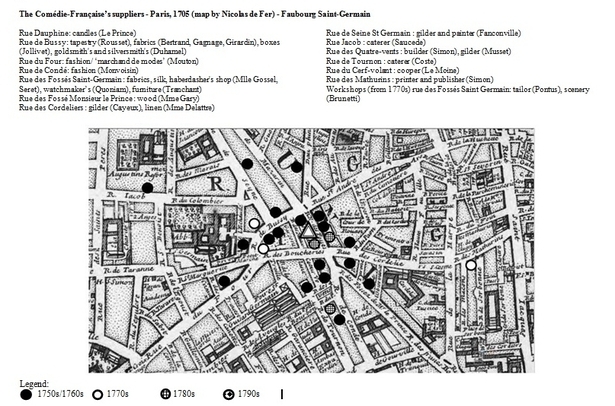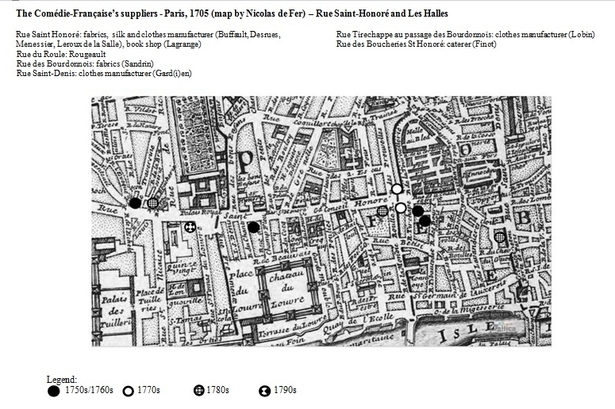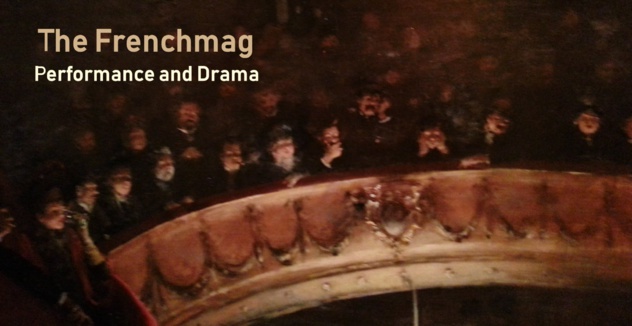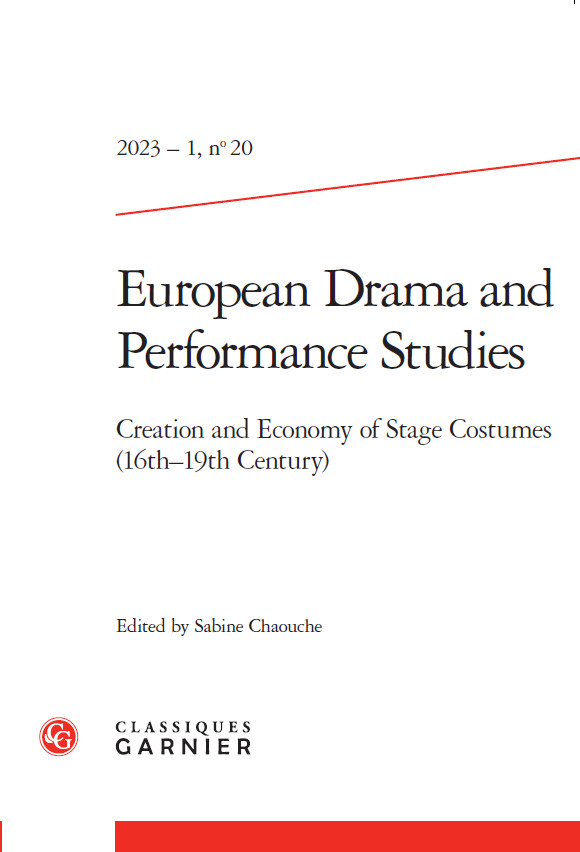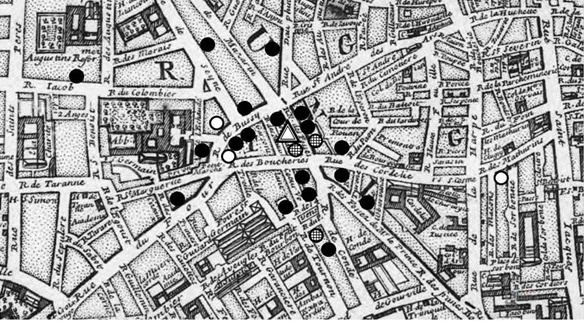
What was the Comédie-Française’s logistics within Paris and its network of suppliers?
Not all the documents give the details of the suppliers. Thirty-three addresses were collected. Twenty-three suppliers were located in the same quartier as the playhouse.
Most of them were already trading with the company in the 1750s and 1760s, i.e. before the move to the Tuileries and the Salle des Machines. More interestingly the actors could buy goods or orders products locally. They could go rue Dauphine to order candles (Le Prince); rue de Bussy to order tapestry (Rousset), fabrics (Bertrand, Gagnage, Girardin), boxes (Jollivet) or to deal with Duhamel, goldsmith’s and silversmith’s. They could go rue du Four or rue de Condé to buy from the marchand de mode (Mouton, Monvoisin), rue des Fossés Monsieur le Prince to be supplied in wood (Mme Gary), rue des Cordeliers, rue de Seine St Germain or rue des Quatre-vents to order gilt (dorure) (Cayeux, Fanconville, Musset), Rue des Mathurins : printer and publisher (Simon) etc. [See below: map 1]
Many shops were located rue des Fossés Saint-Germain (i.e. where the playhouse was built): fabrics, silk, a haberdasher's shop (Mlles Gossel, Seret), a watchmaker’s (Quoniam), or furniture (Tranchant) could serve their interests. Only 10 suppliers were located in the rue Saint Honoré area, which were, not surprisingly, mainly cloth manufacturers. Their number remained limited, even after 1770, which suggests that the Comédie-Française privileged local traders. [See below: map 2]
A commercial local presence had great advantages: actors could place urgent orders; they could limit transport costs and get goods more quickly - the centre of Paris and the different bridges were usually very crowded during the day -; they could keep an eye on their suppliers. In return, the playhouse commercial activities impacted on the economics of the area by maintaining a high demand and by also stimulating the offer. The Marchandes de mode were sometimes directly influenced by plays which had a huge success: Mlles Gossel, located Carrefour de Bussy sold “a pouf à la Figaro” in October 1789. Fashion trends but also a primary form of merchandising derived directly from the influence of the productions such as fans or handscreens or gravures à retombe as stated by Nathalie Rizzoni in two of her articles (1).
Moreover, as can be seen in the different Almanacs from the 1760s, actors did not just favour local trade around the playhouse. They also deliberately decided to live in the same area, along with most of their employees. In 1766, practically all the members of the company lived in the Saint-Germain area. They had therefore an absolute control over it.
When they moved to the Tuileries, the playhouse rue des Fossés Saint-Germain was converted into workshops and a warehouse. Brunetti (set-designer) and Pontus (tailor) were based there. The main Magasin or warehouse was located rue des Mauvais-Garçons (a building adjacent to the playhouse). In the 1770s another one was created conveniently around the Tuileries (rue de la Baroulière).
The company had another warehouse in the Saint-Laurent fair, in the north of Paris, by the warehouse of the Menus Plaisirs rue Bergère (some sets were stored there).
Suppliers, actors, musicians, lawyers but also workshops were gathered in the same area. A high level of activities would therefore liven up the quartier.
By having strong networks, by benefitting from a large concentration of shopkeepers at local level, and by grouping its main suppliers, the tailor and the painter-and-decorator in their old playhouse, the Comédie-Française ensured a smooth day-to-day running of its business and productions from the 1760s to the 1780s. This strategy strengthened the economic life of the Faubourg Saint-Germain and participated fully in the rise of consumption.
Sabine Chaouche
(1) Nathalie Rizzoni, “An Exceptional and Unpublished Series of Eighteenth-Century Theater By-Products: the Handscreens and Fan of Blaise et Babet, a Play by Monvel and Dezède (circa 1783)”.
http://cesar.org.uk/cesar2/conferences/conference_2008/rizzoni_08.html.
“Une précoce anticipation du cinéma d'animation : les gravures à retombe de l’Ambigu-Comique vers 1780”.
http://cesar.org.uk/cesar2/conferences/cesar_conference_2006/Rizzoni_paper06.html
Not all the documents give the details of the suppliers. Thirty-three addresses were collected. Twenty-three suppliers were located in the same quartier as the playhouse.
Most of them were already trading with the company in the 1750s and 1760s, i.e. before the move to the Tuileries and the Salle des Machines. More interestingly the actors could buy goods or orders products locally. They could go rue Dauphine to order candles (Le Prince); rue de Bussy to order tapestry (Rousset), fabrics (Bertrand, Gagnage, Girardin), boxes (Jollivet) or to deal with Duhamel, goldsmith’s and silversmith’s. They could go rue du Four or rue de Condé to buy from the marchand de mode (Mouton, Monvoisin), rue des Fossés Monsieur le Prince to be supplied in wood (Mme Gary), rue des Cordeliers, rue de Seine St Germain or rue des Quatre-vents to order gilt (dorure) (Cayeux, Fanconville, Musset), Rue des Mathurins : printer and publisher (Simon) etc. [See below: map 1]
Many shops were located rue des Fossés Saint-Germain (i.e. where the playhouse was built): fabrics, silk, a haberdasher's shop (Mlles Gossel, Seret), a watchmaker’s (Quoniam), or furniture (Tranchant) could serve their interests. Only 10 suppliers were located in the rue Saint Honoré area, which were, not surprisingly, mainly cloth manufacturers. Their number remained limited, even after 1770, which suggests that the Comédie-Française privileged local traders. [See below: map 2]
A commercial local presence had great advantages: actors could place urgent orders; they could limit transport costs and get goods more quickly - the centre of Paris and the different bridges were usually very crowded during the day -; they could keep an eye on their suppliers. In return, the playhouse commercial activities impacted on the economics of the area by maintaining a high demand and by also stimulating the offer. The Marchandes de mode were sometimes directly influenced by plays which had a huge success: Mlles Gossel, located Carrefour de Bussy sold “a pouf à la Figaro” in October 1789. Fashion trends but also a primary form of merchandising derived directly from the influence of the productions such as fans or handscreens or gravures à retombe as stated by Nathalie Rizzoni in two of her articles (1).
Moreover, as can be seen in the different Almanacs from the 1760s, actors did not just favour local trade around the playhouse. They also deliberately decided to live in the same area, along with most of their employees. In 1766, practically all the members of the company lived in the Saint-Germain area. They had therefore an absolute control over it.
When they moved to the Tuileries, the playhouse rue des Fossés Saint-Germain was converted into workshops and a warehouse. Brunetti (set-designer) and Pontus (tailor) were based there. The main Magasin or warehouse was located rue des Mauvais-Garçons (a building adjacent to the playhouse). In the 1770s another one was created conveniently around the Tuileries (rue de la Baroulière).
The company had another warehouse in the Saint-Laurent fair, in the north of Paris, by the warehouse of the Menus Plaisirs rue Bergère (some sets were stored there).
Suppliers, actors, musicians, lawyers but also workshops were gathered in the same area. A high level of activities would therefore liven up the quartier.
By having strong networks, by benefitting from a large concentration of shopkeepers at local level, and by grouping its main suppliers, the tailor and the painter-and-decorator in their old playhouse, the Comédie-Française ensured a smooth day-to-day running of its business and productions from the 1760s to the 1780s. This strategy strengthened the economic life of the Faubourg Saint-Germain and participated fully in the rise of consumption.
Sabine Chaouche
(1) Nathalie Rizzoni, “An Exceptional and Unpublished Series of Eighteenth-Century Theater By-Products: the Handscreens and Fan of Blaise et Babet, a Play by Monvel and Dezède (circa 1783)”.
http://cesar.org.uk/cesar2/conferences/conference_2008/rizzoni_08.html.
“Une précoce anticipation du cinéma d'animation : les gravures à retombe de l’Ambigu-Comique vers 1780”.
http://cesar.org.uk/cesar2/conferences/cesar_conference_2006/Rizzoni_paper06.html
